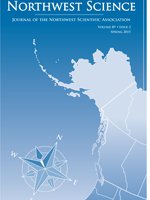Estuaries are biologically productive and diverse ecosystems that provide ecosystem services including protection of inland areas from flooding, filtering freshwater outflows, and providing habitats for fish and wildlife. Alteration of historic habitats, including diking for agriculture, has decreased the function of many estuarine systems, and recent conservation efforts have been directed at restoring these degraded areas to reestablish their natural resource function. The Nisqually Delta in southern Puget Sound is an estuary that has been highly modified by restricting tidal flow, and recent restoration of the delta contributed to one of the largest tidal salt marsh restorations in the Pacific Northwest. We correlated the response of nine major tidal marsh species to salinities at different elevation zones. Our results indicated that wetland species richness was not related to soil pore-water salinity (R2 = 0.03), but were stratified into different elevation zones (R2 = 0.47). Thus, restoration that fosters a wide range of elevations will provide the most diverse plant habitat, and potentially, the greatest resilience to environmental change.
How to translate text using browser tools
1 May 2015
Vegetation Community Response to Tidal Marsh Restoration of a Large River Estuary
Lisa J. Belleveau,
John Y. Takekawa,
Isa Woo,
Kelley L. Turner,
Jesse B. Barham,
Jean E. Takekawa,
Christopher S. Ellings,
Gerardo Chin-Leo
ACCESS THE FULL ARTICLE

Northwest Science
Vol. 89 • No. 2
May 2015
Vol. 89 • No. 2
May 2015
elevation
Nisqually River Delta
salinity
tidal salt marsh




